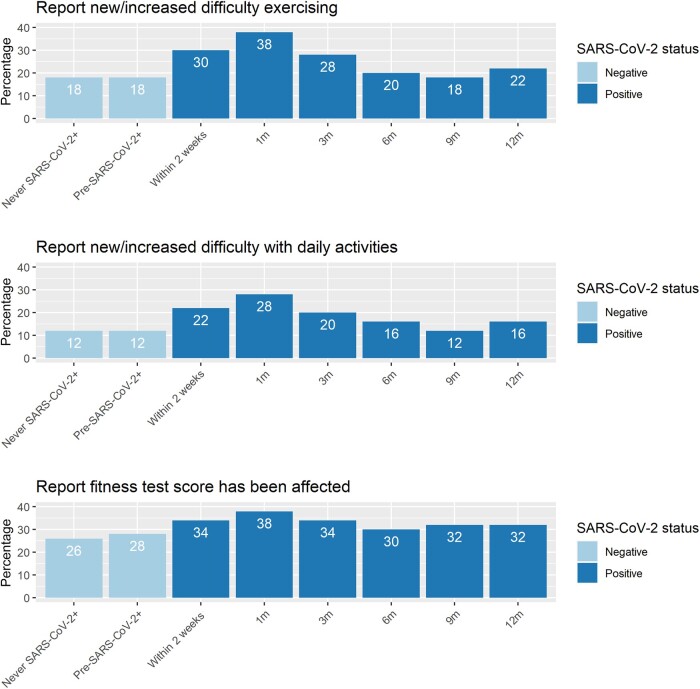
Click to Enlarge: Responses to fitness survey questions, by time. The numbers in the bars represent the percentage of subjects who reported difficulty with exercise, daily activities (ie, walking or going up stairs), or physical fitness test score. Participants who never tested positive are included in the “never SARS-CoV-2+” group, and their answers are summarized over all surveys. Abbreviation: SARS-CoV-2, severe acute respiratory syndrome coronavirus 2. Source: Open Forum Infectious Disease
SILVER SPRING, MD — Healthy, young members of the military who have had COVID-19 may experience impairments in fitness up to a year after their acute illness has resolved—even if they experienced a relatively mild case, a new study suggests. Vaccination and boosters were associated with a lower risk of self-reported fitness loss, however.
While multiple studies have shown long-term effects of COVID-19 infection, including loss of fitness as measured by cardiopulmonary exercise testing, older age groups and those with severe cases requiring hospitalization have generally been overrepresented in those studies.
“In such groups, the described post-hospitalization fitness loss may be nonspecific and reflect expected deconditioning, which is common after hospitalization for other acute conditions, particularly in older adults”, wrote authors of the study, which appeared in Open Forum Infectious Diseases. “By comparison, there are few data on the fitness impact in younger age groups with milder acute COVID-19.”1
Researchers at the Uniformed Services University of the Health Sciences conducted the study to understand the effects of COVID-19 infection in a younger, healthier population—specifically beneficiaries of the MHS, comprised of uniformed servicemembers, military retirees and family members.
“Our organization is devoted to supporting the readiness of U.S. warfighters. Physical fitness sufficient for combat and other mission essential activities is a foundational aspect of readiness,” explained Robert O’Connell, MD, chief of the Department of Laboratory Diagnostics and Monitoring, Walter Reed Army Institute of Research, and one of the study’s authors.
The study enrolled MHS beneficiaries—both adults and children—who were outpatient or inpatient confirmed COVID-19 cases, those exposed to SARS-CoV-2, who had COVID-like illness, those tested for SARS-CoV-2 or who received a COVID-19 vaccine, said O’Connell. Participants were enrolled between March 2020 and May 2022 across 10 sites and an online recruitment pathway. “For this specific analysis, we evaluated demographics, body mass index, co-morbidities, SARS-CoV-2 tests, vaccination status and survey results related to fitness and daily activities in U.S. military servicemembers,” he told U.S. Medicine.
The participants in this analysis were primarily young adults—75% were age 18-39 years—and 71.5% were male. Participants with a history of SARS-CoV-2 infection were more likely to report difficulty exercising (38.7% vs.18.4%), difficulty performing daily activities (30.4% vs. 12.7%).
Tests Affected
Further, a substantial proportion of U.S. servicemembers in the cohort reported that their service-mandated physical fitness test (PFT) scores were affected after COVID-—a proportion that was significantly higher than in those without a known history of SARS-CoV-2 infection. The researchers noted that servicemembers still reported their test scores were affected for 12 or more months, although they suggested this might reflect the frequency of fitness testing (typically once or twice per year).
Being fully vaccinated was associated with decreased risk of reporting difficulties with exercise and daily activities by approximately 20%, the researchers reported. Participants with full vaccination, plus at least one booster dose prior to infection, were less likely to have impaired fitness than those with who did not receive a booster dose. “These findings provide evidence that the COVID-19 vaccine, and booster, may prevent long-term sequelae of infection, including fitness loss, even in those who are younger and who were not hospitalized for their initial infection,” O’Connell said.
A surprising finding, he pointed out, was that the military population in this study experienced difficulties with physical fitness during the COVID-19 pandemic regardless of SARS-CoV-2 diagnosis. “In spite of mostly mild initial illness, those with SARS-CoV-2 positive tests were significantly more likely to experience these difficulties.”
That finding was key because understanding the burden of long-term impaired fitness caused by SARS-CoV-2 infection in a relatively young and healthy population is important for public health, O’Connell said. “Long COVID—post-COVID condition—is increasingly recognized as a significant public health problem, involving different organ systems and with varied phenotypes.”
Prior research has typically focused on individuals with more severe acute infections—typically those hospitalized—and often lacked a SARS-CoV-2 negative comparison group, he explained. Endpoints such as occupational fitness have not been a focus of most long COVID studies, he said. “Understanding the impact of vaccination and vaccine boosting on mitigating post-COVID-19 fitness loss—including in younger populations who have particularly low vaccine boosting uptake—is important.” He said further studies in this and other populations, including direct fitness scores rather than self-reported scores, are needed.
- Richard SA, Scher AI, Rusiecki J, Byrne C, et. Al; EPICC COVID-19 Cohort Study Group. Decreased Self-reported Physical Fitness Following SARS-CoV-2 Infection and the Impact of Vaccine Boosters in a Cohort Study. Open Forum Infect Dis. 2023 Nov 17;10(12):ofad579. doi: 10.1093/ofid/ofad579. PMID: 38130596; PMCID: PMC10733205.

